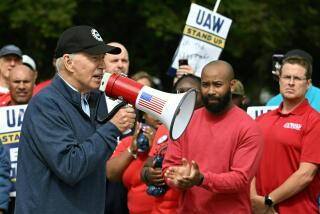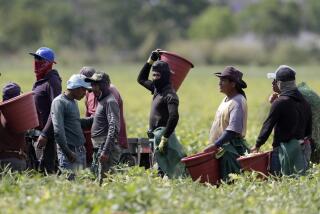Employers to be new targets of enforcement
In a major departure from the Bush administration, the Department of Homeland Security on Thursday issued new work site enforcement guidelines that shift the focus to employers rather than illegal workers and could be a harbinger of more immigration reforms.
The federal guidelines instruct agents to conduct “carefully planned criminal investigations” of employers and to look for evidence that they may be involved in smuggling or visa fraud. Agents are directed to get indictments or search warrants before arresting employees.
Homeland Security officials said the goal was to reduce unfair competition and stem the flow of illegal crossers by targeting the magnet: jobs.
“The prospect for employment . . . continues to be one of the leading causes of illegal immigration,” spokesman Matt Chandler said. “This is a clear message to the millions of businesses who play by the rules, but find themselves competing against others who enter the illegal labor market, that help is on the way.”
During the Bush administration, work site raids led to the arrest and deportation of thousands of illegal workers but few criminal prosecutions of their bosses. In 2008, only 135 of more than 6,000 work site arrests were of employers.
Although some companies deliberately hire and exploit workers, most businesses want a legal workforce -- and a pool of documented workers, said Tamar Jacoby, president of ImmigrationWorks USA, a national federation of businesses.
“Employers have been worried about the tightening enforcement noose for a long time,” Jacoby said. “No employer looks forward to getting raided, but they really want a system that works.”
Labor needs were discussed Thursday during a Senate judiciary subcommittee hearing on immigration reform.
During the hearing, Sen. Dianne Feinstein (D-Calif.) said reform was urgently needed to aid California’s agricultural sector, which she said could lose as much as $3.3 billion this year because of a worker shortage. “We’d all be delighted to have Americans do the work. But the fact is they won’t,” she said. “We need a program that will get a stable and continuing supply of labor.”
The economic recession and high unemployment rate have raised questions as to whether President Obama would follow through on campaign promises to pursue an immigration overhaul and legalization of the nation’s estimated 12 million illegal immigrants.
In his news conference Wednesday, Obama reiterated his pledge to overhaul the system. He said he hoped to convene a “working group” to come up with a framework for legislation, and signaled that he would use existing laws to help lay that groundwork.
Employer enforcement is the first of those initiatives. The work site issue drew headlines in February after dozens of workers were arrested at a manufacturing plant in Bellingham, Wash. Homeland Security Secretary Janet Napolitano ordered a review of the raid and sped up the process of revamping the rules.
“This is definitely part of a broader effort to maximize all of our enforcement resources and that uses them in a smart and efficient way that is consistent with the secretary’s philosophy,” a senior Homeland Security official said. “You need to start with the demand side of the equation.”
The new guidelines, which stress that illegal workers will still face arrest, have received mixed responses from groups on both sides of the debate.
Immigrant rights groups welcomed a new focus on abusive employers but said the government should go after the employers for violating labor and immigration laws. They also said workers should not be detained and deported but rather used as material witnesses against their bosses.
American Immigration Law Foundation senior policy analyst Michele Waslin said the work site changes were a first step but that Congress and the White House needed to follow through by pushing reform.
“There is only so far that these guidelines can take us, given the fact that we have a broken immigration system,” she said. “We need to reform our immigration laws so that law-abiding employers have the means to access the workers they need and so we can protect the rights of all workers.”
Roy Beck, executive director of NumberUSA, which views illegal immigration as damaging to the U.S. economy, said that he was hopeful that there would be more raids under the new guidelines and that the new focus would deter employers from hiring illegal immigrants. “The point of the raids is not how many people get arrested, how many employers go to jail, how many illegals get deported,” he said. “The point is how many employers that you scare into not hiring illegals and how many illegals you scare into going back home.”
But Federation for American Immigration Reform President Dan Stein said the new protocols were meaningless unless the public started to see investigations, prosecutions and “bad actors going to jail.” Stein said the administration had been scaling back on immigration enforcement.
“We can expect from this administration a series of meaningless and empty pronouncements about enforcement in an effort to mislead the public and to promote their big amnesty plan,” Stein said.
Immigration reform last died in 2007 in the Senate, when lawmakers couldn’t reach a compromise on thorny issues such as guest workers and legalization.
The chances for success may not have improved at this politically perilous time, when Congress is dealing with the economic crisis, sweeping healthcare legislation and an energy plan.
--
joliphant@latimes.com
More to Read
Start your day right
Sign up for Essential California for news, features and recommendations from the L.A. Times and beyond in your inbox six days a week.
You may occasionally receive promotional content from the Los Angeles Times.






